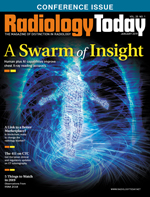 MRI Monitor: Toning Down the Contrast — Using AI to Reduce Gadolinium Dose
MRI Monitor: Toning Down the Contrast — Using AI to Reduce Gadolinium Dose
By Enhao Gong, PhD
Radiology Today
Vol. 20 No. 1 P. 28
Because MRI provides superior tissue contrast, it is routinely used to provide noninvasive diagnosis of a wide variety of medical conditions. Gadolinium-based contrast agents (GBCAs) also play a critical role in MR imaging, as they enhance image clarity and often provide better highlights and delineation of pathologies. Currently, GBCAs are used for about one-third of MRI studies. About half a billion doses have been administered worldwide.
Since 2013, however, researchers in Japan and the United States have begun discovering that small amounts of GBCAs accumulate in patients' bodies and brains, in particular after repeated GBCA dosing. Additional research has confirmed these findings and provided further evidence of the possible risks that contrast agents pose. While the potential extent of these risks has stirred controversy, the evidence has triggered significant concerns in the radiology and regulatory communities. Several suspensions of GBCAs have been issued by the European Medicines Agency. The FDA and additional regulatory agencies worldwide have also issued warnings.
Guided by principles similar to the ALARA principle, which holds that radiation exposure for both patients and imaging personnel should be minimized, radiologists have been increasingly concerned about minimizing GBCA dose in their practices.
GBCAs are divided into two categories based on their molecular structure: linear and macrocyclic. Linear agents coil around the gadolinium like a snake around an egg. Macrocyclic agents form a clamshell-like wrap around the gadolinium and are considered more stable with a tighter casing. Radiologists' concerns around minimizing GBCAs are evidenced by the growing trend away from the use of linear GBCAs toward macrocyclic GBCAs, which reflects the intention to find alternative and safer solutions in clinical practice. From both cost and legal perspectives, hospitals are also considering applying technologies to reduce the contrast dosage.
The concern about GBCAs is so great among radiologists that gadolinium deposition ranked second among the most popular topics presented at RSNA 2017. Interestingly, the application of AI in radiology topped the ranks. When talking about AI in medical imaging, most people are more familiar with the concept of using it to aid in the detection of abnormalities in images for disease diagnosis. However, more and more research demonstrates that AI can deliver benefits across the entire spectrum of imaging workflow, from acquisition to analysis. So why not leverage state-of-the-art AI technologies to resolve the pressing issue of gadolinium deposition?
Low-Dose Research
Along with a larger research group from Stanford University, I posed this question and researched the possibilities. The results were encouraging, demonstrating the potential of AI to help enhance the subtle image contrast that skilled radiologists cannot discern in standard MRI images.
Along with Greg Zaharchuk, MD, PhD, and additional colleagues, I participated in research that demonstrated for the first time that AI can significantly reduce the dosage of gadolinium required for MRI to provide a clinically acceptable enhanced image. Using dozens of routine brain MRIs, our research showed that the AI model can be trained to algorithmically enhance the subtle changes apparent with only 10% of the routine gadolinium dosage. The algorithm uses deep learning—part of a broader family of machine learning methods, all under the AI umbrella—based on learning data representations, as opposed to task-specific algorithms.
This deep learning algorithm is used to train neural network models that can synthesize images similar to standard contrast-enhanced MRI images from lesser dose images. The research found degradation in neither overall image quality nor contrast enhancement, despite the 10-fold reduction in gadolinium dosage. The study was published in the Journal of Magnetic Resonance Imaging in February 2018, with follow-up research on a larger cohort of patients that was presented at RSNA 2018.
Clinical Impact
We are hopeful that this technology may open doors to clinical applications using a minimal dosage of MRI contrast to achieve high-quality images, creating a far more favorable balance between diagnostic value and gadolinium administration risk. For example, MRI contrasts are routinely employed for imaging neurological patients with multiple sclerosis. Using this new AI technology, patients would be administered the same dosage of gadolinium in 10 exams as they would receive in just a single standard scan.
In addition, at the recent International Society for Magnetic Resonance in Medicine Machine Learning workshop in Washington, D.C., our team presented our latest research on a zero-dose MRI technique that uses multiple noncontrast MRI images to approximate the appearance of gadolinium contrast-enhanced MRI images. This represents a significant step forward in MRI patient safety.
Clinicians are becoming more aware of contrast agent issues and increasingly open to exploring alternative dosing, as they become more cautious when making decisions on contrast administration protocols. In general, the radiological community is starting to acknowledge the potential risks of gadolinium deposition and is seeking alternative solutions to maximize safety while maintaining diagnostic quality. AI in radiology is an inevitable trend—as a way to enhance the effectiveness of radiologists, not to replace them. The more achievable and valuable goal is to apply AI toward making MRI exams safer and smarter with less GBCA exposure.
— Enhao Gong, PhD, is the cofounder of Subtle Medical.

